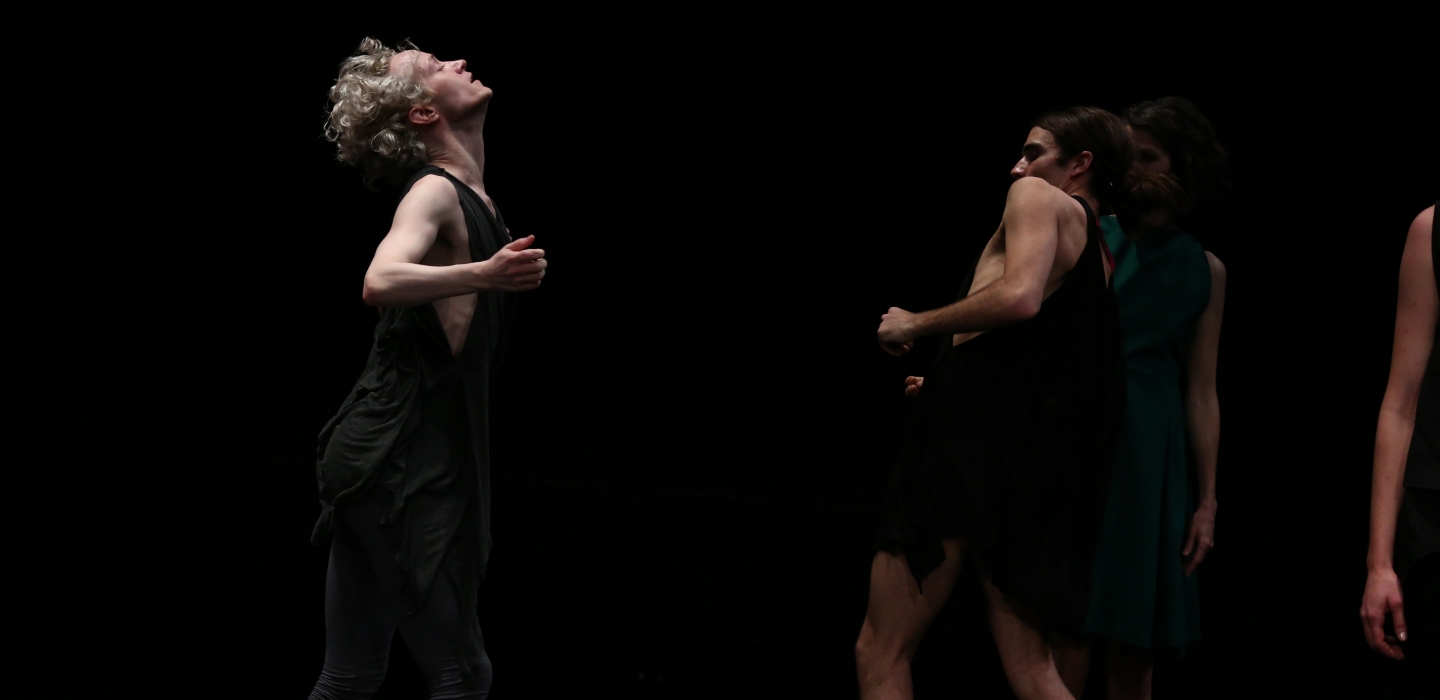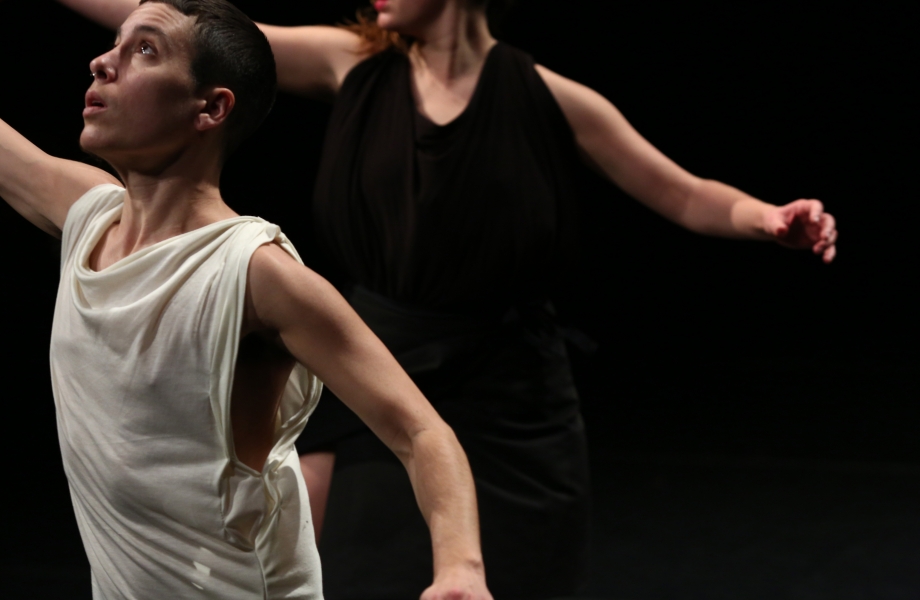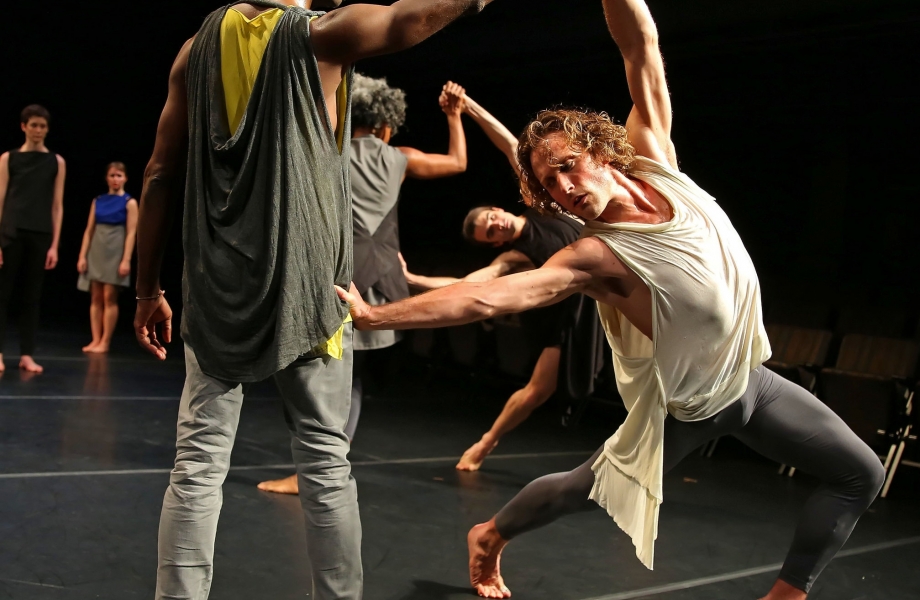Road Trip

He asked us to imagine ourselves in a car, traversing through a landscape, seatbelts on. When traffic slows and then stops, we’re all stuck—and even though you spend that time trying to decipher the license plate of the car in front of us while I stare into space and imagine I’m anywhere else, we are all relieved when we finally inch past the accident and speed up again. We’re all independently doing things to pass time on the road, but we all feel the bump when the car skips over the pothole.
The choreographer Tere O’Connor argues that this metaphor (both seductive and reductive in its simplicity) is what choreography does—or more specifically, it’s what he aims to do in his dances. He creates movement in a landscape developed by his interactions with dancers; the audience is invited to traverse this geography, their eyes moving across the field, albeit on a path charted by the choreographer.
BLEED begins with the lithe Heather Olson center stage, noodling around as she steps back and forth, seeming to grab at the air to pull space into herself. My eyes follow her gestures until other dancers emerge along diagonals, forming a processional of sorts as they dart in and out of formation. The group’s shifting patterns absorb my attention until Olson suddenly gasps and falls to the ground, immediately surrounded by the rest of the cast and illuminated by a single spotlight. My perspective zooms onto Olson, as if a film had abruptly cut to another scene. As my focus narrows my questions mount. Is Olson ok? What is her relationship to the group? Are they her aggressors or saviors?
Despite a dramatic scene like this, O’Connor is quick to assert that dance is not a form for telling stories or presenting an argument; rather, he characterizes choreography as the practice of developing a language. Just as individual words are only given meaning by their semantic structure within a sentence, he focuses on how relationships within a dance (transitions between sequences, the varied length of phrases within a longer sequence, the spatial positioning of a group) shape interpretation. O’Connor undermines the narrative thrust by focusing on the punctuation and elisions between sections, what he has called “the grammar eating the nouns.”
Later in BLEED, devyn emory chases Oisín Monaghan around the stage as they wind between other members of the cast, playing what seems to be a game of tag. Just when Monaghan seems within emory’s grasp their pathway subtly spirals, turning from a pursuit to two parallel circular patterns, which gradually widen, speeding up to expand into a circle encompassing the entire cast. As one understanding of a relationship quickly morphs into another, O’Connor’s work encourages me to reconsider the supposedly strict distinctions between narrative and abstract composition. It is this slippery quality in his work that I find most fascinating—pushing me to look harder and reconsider that which at first seems recognizable or easy to understand.

O’Connor argues that dance itself is the protagonist of the work, that by refusing to use dance as a tool to tell a story the work becomes about dance itself. This focus on form can be traced to Merce Cunningham, a choreographer whose practice was unapologetically dedicated to an exploration of the body in space. Cunningham dismissed the traditional proscenium orientation of the stage, creating works with multiple fronts that undermined a single perspective. Using chance procedures to determine the relationship between parts of the body and dancers across the space he crafted rigorous, virtuosic pieces that championed movement. O’Connor’s work similarly offers both a commitment to dance as form and an allegiance to the body, a very real and present thing. While focusing on form can often lead to movement that appears abstract, it is danced by individuals whose peculiarities, histories, and relationships with each other continue to resonate onstage, despite movement that does not employ these attributes to tell a story. O’Connor’s work takes up this seeming paradox, dismantling it in the process.
O’Connor grew up in northern New York, near Rochester. He knew he was gay from an early age and realized quickly that others shouldn’t know this; he resisted queries about his sexuality by being funny, pushing attention away from himself by provoking laughter in others. His college years at SUNY Purchase (where he was briefly a theater major before transitioning to dance) were a transformational time during which he embraced his identity as a gay man and discovered the freedom to find joy and beauty in his body. As he navigated this terrain he investigated how he could present subtle gestures in various registers, coding himself to slip seamlessly in and out of a gay vernacular.
This simultaneity of multiple understandings is something O’Connor continues to explore, and it is exemplified in his working process with his dancers. His pieces are a mix of material he develops and delivers to the cast and phrases they create together through improvisational practices—a doubling of modes whose seeming contrasts and unexpected similarities O’Connor skillfully traverses. He calls one aspect of his practice “mentioning,” which he describes as “delivering source material by dancing quickly in front of the dancers and asking them to record or assimilate what they had seen and to develop it further on their bodies.” Here the act of transposition is central—the dancers are not translating O’Connor’s movement, but rather absorbing and adjusting it within their own registers. The immediacy of this process highlights the way each dancer sees material, acknowledging that what each retains and discards reveals a unique mode of understanding. Parallel to this practice the dancers also learn a phrase O’Connor has choreographed, subsequently employing varying improvisational scores that, as O’Connor describes it, “rearrange their material as it was being performed, improvising in and out of its inclusion in the fixed material and restructuring the material on every take.” Throughout, O’Connor highlights his dancers’ experiences; the rubbings of their practices on his own are present in each moment, creating a layered and polyphonic work marked by multiple points of view, as well as the erasure of the author’s original vision.
BLEED, crafted in relationship with three other works (Secret Mary, poem, and Sister) over a two-year period, is in some ways paradigmatic of this layered process. Each of the dancers in BLEED also performed in one of these three other works, and so while BLEED is composed of unique movement material, the presence of the other pieces wafts through the work. In program notes O’Connor describes BLEED as a hybrid work “simultaneously remembering and forgetting the previous dances,” in which “ghosts of the other dances resonate, but they are subterranean and exert their pressure on this new construction from the caves of memory.”
These resonances are a subtly present undercurrent throughout BLEED. Instead of simply quoting phrases from the other dances, O’Connor investigates the act of watching itself, isolating it as the source and sieve of memory. Throughout the piece dancers wind in and out of large patterns as they examine the space around them, recalling an exercise that I often did at the beginning of dance classes: walking around the space, looking at the setting, and opening up my vision, thereby priming my ability to take in the lessons of the class and people around me.

Later on in BLEED dancers sit on either side of the stage and look out at the audience, their fixed gazes mirroring the viewers’ focus on the dancers. In both of these sections watching becomes reflexive, recalling both the presence of the audience and the act of seeing itself—referencing O’Connor’s generative process of “mentioning” and the layered registers that can be used to interpret a work. By considering watching itself O’Connor draws attention to the way in which perception determines memory, which goes on to influence understanding and ultimately the process of new creation. BLEED in particular asks questions about lineage: How is the memory of work stored in the body? How does a dancer’s past experience of a choreographer’s work influence their performance? And in what ways does O’Connor continue to be affected by his own early work? All of these considerations are determined by perspective—that of the viewer, the dancer, and the choreographer.
O’Connor’s focus on perspective reminds me of his car analogy; returning to it I am in turn reminded of the artist Tony Smith’s drive down the New Jersey Turnpike. Smith recounted his experience in an interview in Artforum in 1966:
When I was teaching a Cooper Union in the first year or two of the ‘50s, someone told me how I could get on to the unfinished New Jersey Turnpike. I took three students and drove. It was a dark night and there were no lights or shoulder markers, line, railings or anything at all except the dark pavement moving through the landscape of the flats, rimmed by hills in the distance, but punctuated by stacks, towers, fumes and colored lights. This drive was a revealing experience. The road and much of the landscape was artificial, and yet it couldn’t be called a work of art. On the other hand, it did something for me that art had never done. At first I didn’t know what it was, but its effect was to liberate me from many of the views I had had about art. It seemed there had been a reality there which had not had any expression in art. The experience on the road was something mapped out but not socially recognized. I thought to myself, it ought to be clear that’s the end of art. Most paintings look pretty pictorial after that. There is no way you can frame it, you just have to experience it.
Through this drive Smith encounters a landscape that is unfinished and, at that moment, without a charted path. He notes the discursive function of the turnpike: while it is embedded in a landscape that could be traversed, it is not yet directed towards a given point or easily captured in a snapshot—what he terms “socially recognized.” Just as Smith drove the car and his passengers (notably students) experienced the unfinished New Jersey turnpike through his choices of speed and direction, O’Connor drives in BLEED, traversing a landscape through a series of carefully executed transitions. And while the work is clearly O’Connor’s, he is hesitant to lay claim to my understanding from the backseat, because it is my perspective—one of an infinite multitude of experiences. And yet, the experience I’m given is exacting. I don’t get to determine if we turn left or right at the fork, or even if the windows are up or down. Ignoring the limits of the given vantage point assumes that I have a wider range of perspective than is possible from the back seat. Overly asserting the agency of the viewer ultimately disregards underlying systems that help to determine perspectives. O’Connor’s analogy assumes I fit in the car, which brings up the larger question—for whom is the car built?
BLEED seems to consider this question of perspective in particular, employing strategies of refusal, multiplicity, and erasure to undermine a singular viewpoint. O’Connor acknowledged that the car metaphor isn’t perfect, and it certainly isn’t the only vehicle for understanding his choreographic practice. I return to it only to highlight the way in which his work can unite an audience for an hour in a similar understanding of time, even as it continues to probe the many different ways of watching and understanding the actions within the sixty minutes of BLEED. Smith’s conclusion after his drive that there can be no singular frame, but solely an experience, is what holds most true to me. O’Connor’s work is breathtakingly beautiful, filled with patterns and elisions that disappear only to make you realize you loved them, and wish them to return. And it is layered and challenging—offering something to continually probe and grapple with. That is what is most exciting for me about O’Connor’s work: the constant, unsettling shift that leaves me reconsidering old habits and encourages me to look anew.
